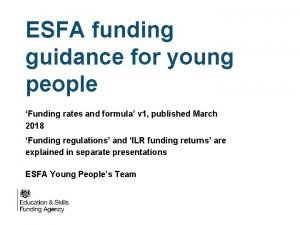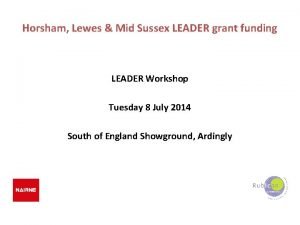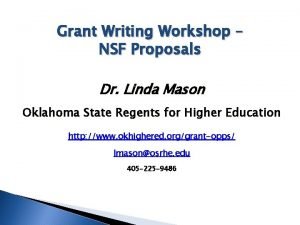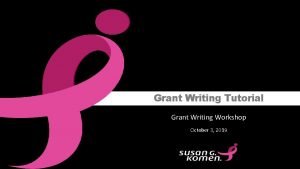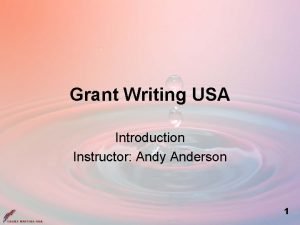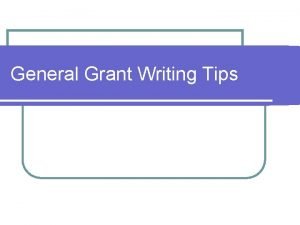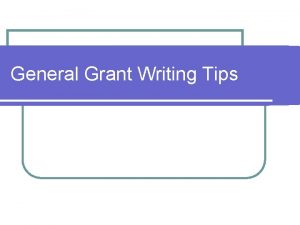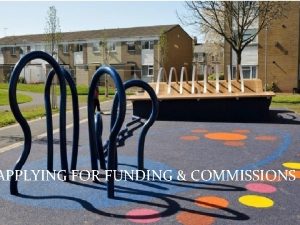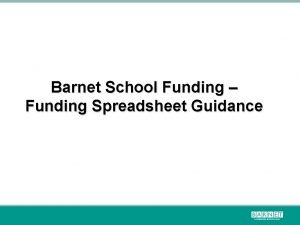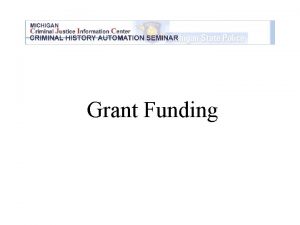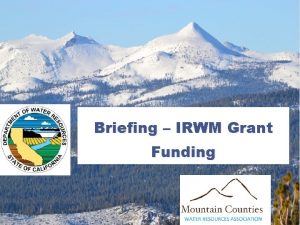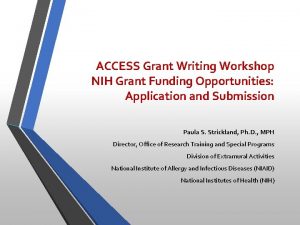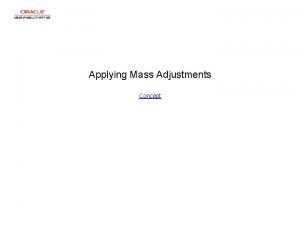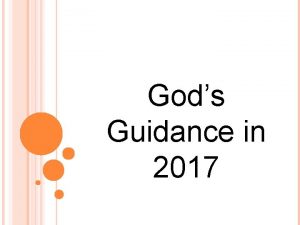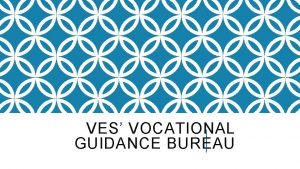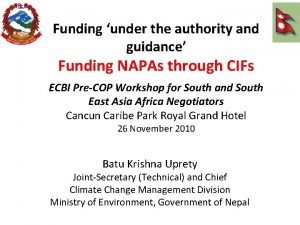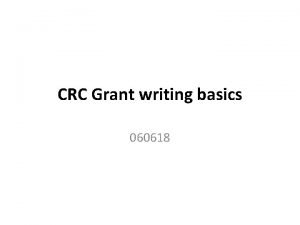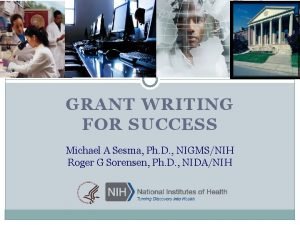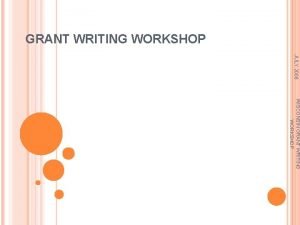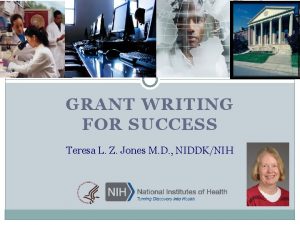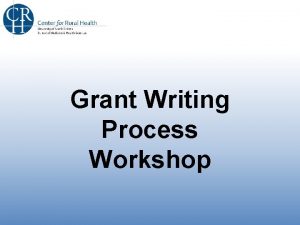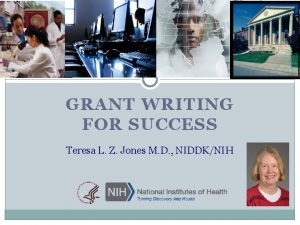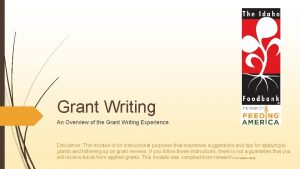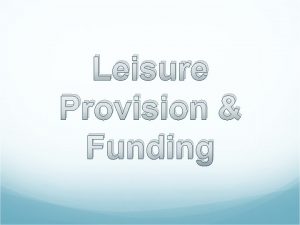Applying for Grant Funding General Grant Writing Guidance

























- Slides: 25

Applying for Grant Funding General Grant Writing Guidance

Today’s Office Hours Consultant: Pam Baston • Pam has been in the substance use disorder prevention and treatment field for 41 years. During the past 20 years, she has engaged in grant writing (part-time) and has a 90% successful win rate. She will share practical strategies.

VERY helpful resources • https: //www. samhsa. gov/sites/default /files/grant-application-manual. pdf • You can read more information about this registration process beginning on page 15 of the SAMHSA document pictured left. Also check out this webinar slide deck: • https: //www. samhsa. gov/sites/default /files/foa-applicant-webinar. pdf

Tribal Opioid Response (TOR) Basics • https: //www. samhs a. gov/grants/grantannouncements/ti 21 -007

Tribal Opioid Response (TOR) Basics • The applicant must be a federally recognized American Indian or Alaska Native tribe or tribal organization. Tribes and tribal organizations may apply individually, as a consortia, or in partnership with an urban Indian organization. Tribes and tribal organizations may only be included in one grant application. • • • Anticipated Total Available Funding $37, 647, 916 Anticipated Number of Awards Approximately 150 Anticipated Award Amount See Appendix K Length of Project 2 years Cost Sharing/Match Required? No


Section A:

Documenting needs: Many methods Direct methods: Data for determining community needs can be collected through: § Surveys § Questionnaires § Focus groups § Public meetings § Direct observations § Key informant interviews These do not have to be super sophisticated or elaborate to be informative!

Documenting needs cont. § Testimonies from clients, families, referral sources, other stakeholders, funders, staff (summaries or quotes from satisfaction/perception of care surveys, focus groups, etc. ) § Waiting lists § Other sources § Don’t forget, if you have insufficient data to tell the story about the strengths and needs related to opioid and stimulant use disorders affecting your tribal community you can budget for this in your grant as an important activity.

Source: 8

While not tribespecific, this is a great AIAN • https: //www. sa substance use mhsa. gov/data prevalence data /sites/default/fi 3 source les/reports/rpt 23246/1_AIAN _2020_01_14 _508. pdf


SAMHSA Office of Tribal Affairs and Policy (OTAP) https: //www. samhsa. gov/tribal-affairs

Section B:

Required Activities • SAMHSA Goals: To reduce unmet treatment need and opioid overdoserelated deaths through the provision of prevention, treatment, and recovery support services for OUD and, if so desired, stimulant misuse and use disorders. • Increase access to culturally appropriate and evidence-based treatment, including medication-assisted treatment (MAT) using Food and Drug Administration (FDA)-approved medications for the treatment of opioid use disorder (OUD). • See Funding Opportunity Announcement (FOA) pages 7 -9. Select specific activities from there. • These activities can become your project objectives and you can cluster them under a small number of relevant goals.

Tribal Behavioral Health Agenda The TBHA can be found at https: //store. samhsa. gov/p roduct/The-National-Tribal. Behavioral-Health. Agenda/PEP 16 -NTBHAGENDA •

Section C:

Evidence-based Treatment and Prevention • To reduce unmet treatment need and opioid overdoserelated deaths through the provision of prevention, treatment, and recovery support services for OUD and, if so desired, stimulant misuse and use disorders. • Culturally appropriate • You proposed EBP/Ts should relate to these areas. • Can include any of the 3 FDA-approved opioid treatment medications (methadone, buprenorphine, naltrexone). • The Resource Center, at www. samhsa. gov/ebp-resourcecenter

ONE example: Contingency Management (CM) • CM typically modifies behavior by delivering tangible reinforcements (e. g. , prizes, vouchers, or monetary reinforcement) in exchange for evidence of the desired behavior (e. g. , abstinence, decreased drug use, consumption of prescribed opioid treatment meds/MAT) or by withholding those reinforcers in instances of undesired behavior (e. g. , drinking/drug use). The AI/AN ATTC has a webinar series on this model.

Section D:

Staffing reminders • The key personnel for this program will be the Project Director at a 0. 5 FTE level of effort. • 1 -page job description • 2 -page resume Proposed Staff Qualifications/Level of Effort (LOE) Dara Yazzie 100% FTE; LCSW; 3 yrs. experience w/proposed Native populations with SUD Role/Responsibilities Proj. Dir. will provide clinical supervision…. .

Section E:

Performance Assessment/GPRA • Recipients may use a combined total of up to 25 percent of their grant award for Data Collection and Performance Assessment and Infrastructure Development. • See page 10 of the FOA. • Examples of the type of data collection tools required can be found here. Data will be collected via a face-to-face interview using this tool at three data collection points: intake to services, six months post intake, and at discharge. Recipients will be expected to do a GPRA interview on all clients receiving treatment, and recovery support services and are also expected to achieve a follow-up rate of 80 percent. GPRA training and technical assistance will be offered to recipients.

Questions?

You've got this and we are here to help! • THANK YOU!!! CALL IF YOU HAVE QUESTIONS: Jeff Ledolter at • jeff-Ledolter@uiowa. edu • 319 -321 -2555
 Esfa funding
Esfa funding Where did general lee surrender to general grant?
Where did general lee surrender to general grant? Leader grant funding
Leader grant funding Vertical
Vertical Difference between direct and indirect guidance
Difference between direct and indirect guidance Presentation
Presentation Proposal writing on career guidance workshop
Proposal writing on career guidance workshop Proposal writing on career guidance workshop
Proposal writing on career guidance workshop Grant writing examples
Grant writing examples Grant writing tutorial
Grant writing tutorial Grant writing usa
Grant writing usa Kontinuitetshantering
Kontinuitetshantering Novell typiska drag
Novell typiska drag Tack för att ni lyssnade bild
Tack för att ni lyssnade bild Vad står k.r.å.k.a.n för
Vad står k.r.å.k.a.n för Varför kallas perioden 1918-1939 för mellankrigstiden?
Varför kallas perioden 1918-1939 för mellankrigstiden? En lathund för arbete med kontinuitetshantering
En lathund för arbete med kontinuitetshantering Kassaregister ideell förening
Kassaregister ideell förening Personlig tidbok
Personlig tidbok Sura för anatom
Sura för anatom Förklara densitet för barn
Förklara densitet för barn Datorkunskap för nybörjare
Datorkunskap för nybörjare Tack för att ni lyssnade bild
Tack för att ni lyssnade bild Mall debattartikel
Mall debattartikel Magnetsjukhus
Magnetsjukhus Nyckelkompetenser för livslångt lärande
Nyckelkompetenser för livslångt lärande
